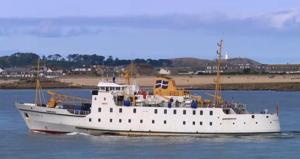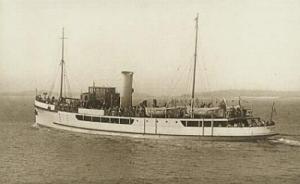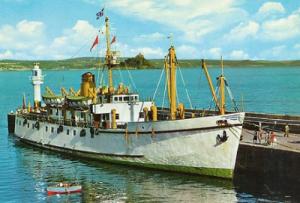


Isles of Scilly Steamship Company Limited,
Quay Street, Penzance TR18 4BZ,
Tel: (01736) 334220
Email: sales@islesofscilly-travel.co.uk
Web: www.islesofscilly-travel.co.uk
Lifeline to the Isles of Scilly
The Scilly Isles Steam Navigation Company provided shipping services between Cornwall and the Isles of Scilly from 1858 to 1872. The company operated two vessels, the steamship SS 'Scotia' which was on loan for a few months in 1858 and 1859 and the SS 'Little Western' which made her maiden voyage from Penzance to Scilly on 6th December 1858. On the winding up of the company in 1871, the ship was transferred to the West Cornwall Steam Ship Company. She was wrecked on Southward Wells Reef, off Samson on 6th October 1872 while attempting to give assistance to a disabled brigantine ship.
The West Cornwall Steam Ship Company was established in February 1870 to operate ferry services between Penzance and the Isles of Scilly. The following year it took over the 'Little Western' from the Scilly Isles Steam Navigation Company which had been operating on the route since 1858. Their other vessels were the 'Earl of Arran' which was wrecked in 1872, the 'Guide', the 'Queen of the Bay', the 'Lady of the Isles', the 'Lyonesse' and the 'Deerhound'.
Following financial problems the company was acquired by John Banfield who set up the West Cornwall Steamship Company in 1907. He already operated two steam launches around the islands, 'Seagull' and 'Siva', to which he added a 120-ton sailing ship, the 'Golden Light'. The company sold the remaining ferry operating to Penzance and was wound up in 1917. Steam services to the islands were hastily arranged by the Government chartering the 'Lapwing' from a Clyde operator until a new Isles of Scilly Steamship Company could take over in 1920.
Formed on 26th March 1920, the Isles of Scilly Steamship Company initially operated services with the 'Peninnis' (ex-HMS 'Argus'), but it had soon become clear that a purpose-built, new steamer was required. During 1924 the directors of the Steamship Company began considering the purchase of a larger ship and at an Extraordinary General Meeting of Shareholders on 16th June 1925, the Directors were empowered to place the order with Ailsa Shipbuilding Company Ltd of Troon, Scotland. In order to keep their yard open during the economic slump, this work was undertaken at cost, the contract price was £24,500. She was designed to carry 400 passengers and cargo between Penzance and the Isles of Scilly.

The new ferry was launched on 17th November 1925 and named 'Scillonian' by Mrs. A. A. Dorrien-Smith of Tresco Abbey. The ship completed her maiden voyage from Troon at 11 pm on 25th January 1926 and docked at St. Mary's. She made her first time-tabled, commercial trip on Thursday 2nd February 1926 from St. Mary's to Penzance. It took her three and a quarter hours.
At 429 gross tons, 170 feet long, 29 feet wide and 11 feet deep, she was considered, by some, as too big and unsuitable for local seas (the same happened when the second Scillonian went into service in 1956 and again with Scillonian III in 1977). However she proved to be a tremendous improvement and became popular over the years.
The 'Scillonian' served the Isles of Scilly in almost continual service for over 29 years, including the war years of 1939-1945, with 40,000 troop movements being recorded. She operated mainly from Newlyn, when shipping troops, and carried degaussing gear as protection against magnetic mines. Her route out of Newlyn was to creep close to the shore, even between St. Clement's Isle and Mousehole, to avoid setting off acoustic mines. On 12th August 1943 one of the St. Mary's based Hurricane aircraft crashed into her masts killing the pilot.
In thick fog on 10th September 1951 the 'Scillonian' was on her usual journey to St. Mary's. Visibility that day was described by the lifeboat secretary, Trevellick Moyle as "I don't think I have ever seen it thicker". The ship did not have radar and the captain, in poor visibility, often found his bearings by listening for the bell buoy of the Spanish Ledge, or the bugle of Vic Trenwith who would play on Peninnis Head on St. Mary's. The captain heard neither and the Scillonian continued westward and hit the Great Wingletang Ledge on St. Agnes. The fog lifted later that day to find the ship between two rocks and her bow in the air. Nine hours later, at 11 pm, she was re-floated by the tide together with her own engines and a line from the lifeboat, and made her way to the harbour. The next day patched with cement and acetylene welding she was cleared by the Board of Trade as seaworthy to make the return journey to the mainland.
She was replaced by the 'Scillonian II' in 1956 when she was sold to R. W. Fielding.
The 'Scillonian II' was built for the Isles of Scilly Steamship Company in 1955 by John I. Thornycroft & Company of Woolston, Southampton. She was designed to carry 500 passengers with 14 crew and cargo between Penzance and the Isles of Scilly.

The ship was ordered on 18th March 1954 at a contract price of £250,000 planned as a replacement for the first Scillonian which had been in continuous service since 1926. The new ship was laid down on 25th March 1955, completed on 15th November 1955 and christened by HRH The Duchess of Gloucester. The second Scillonian was powered by two 6-cylinder four-stroke diesel engines (manufactured by Ruston & Hornsby) which propelled two three-blade screws, giving the ship a maximum speed of 15.5 knots. She had a gross weight of 921 tons, a length of 208 feet, a beam of 30 feet and a draught of 14 feet.
The new passenger ferry made her first trip to the Isles of Scilly on 23rd March 1956, sailing from Southampton to St. Mary's. Like her predecessor, the second Scillonian operated mainly between Penzance and the Isles of Scilly, although she sometimes diverted to Falmouth or St. Ives in bad weather. A frequent traveller aboard the ship was Harold Wilson who had a holiday home in the Isles of Scilly. Between 1964 to 1966 she was joined on her route by the 'Queen of the Isles'.
She was replaced by the 'Scillonian III' in 1977, and was sold to P & A Campbell.
The RMV 'Scillonian III' was purpose built for the Steamship Company by Appledore Shipbuilders Ltd of Appledore in Devon and was christened by H.R.H. Prince Charles, Duke of Cornwall on 17th May 1977 and entered service later in the same month. She is the third passenger ship to carry the Scillonian name and made her first trip to Scilly on 19th May 1977, sailing from Bideford to St. Mary's.
The 'Scillonian III' has a length of 223 feet, a beam of 39 feet, a draft of 9.5 feet, a gross tonnage of 1255.25, a crew of 18 and a service speed of 15.15 knots. Due to the number of tidal currents which meet off Land's End, and the need for a shallow draught to allow access to the Islands, the sea journey can be rough, causing sea sickness. For this reason the ship is fitted with a "Flume" anti-roll stabiliser system. The ship is also designed to have a shallow draft and can sit on the seabed when there is insufficient water.

The 'Scillonian III' is currently in service for passengers and cargo 8 months of the year, carrying up to 485 passengers for day trips or longer holidays to the Islands. As a preferred means of transport between Scilly and the mainland, she is a familiar sight in Penzance and St. Mary's - often photographed by tourists and also featured in the BBC series, An Island Parish.
In 1998, faced with the cost of building a new ship, the Company decided to give 'Scillonian III' a major refit, during which over 50 tons of steel were used to increase the standard of the ship. The ship also had 3 new generators and a new bow thruster fitted. In April 1999 The Scillonian III was put back into service after the £1,700,000 refit carried out by Devonport Dockyard. In early 2007, press reports indicated that Cornwall County Council was expected to approve plans for the construction of a new roll on roll off ferry at a cost of £17.5 million. This vessel would be leased to the Isles of Scilly Steamship Company and would replace both 'Scillonian III' and 'Gry Maritha'. The scheme subsequently collapsed.
During the winter of 2012 the ship underwent an overhaul which refurbished the passenger accommodation and also extended the ship's service life to 2018.
From new in 1977 the 'Scillonian III' operated a year round route through all weather conditions to service the cargo and passenger transport to and from Penzance and the island of St. Mary's, in the Isles of Scilly. At that time she would run a regular single daily service on weekdays leaving at 09:15 from Penzance and then returning to Penzance from St. Mary's leaving at 15:30. On Saturdays she was scheduled to run a double service leaving earlier in the morning and making a quick turnaround at lunchtime in St. Mary's and then performing a second return voyage in the afternoon. In 1990 it was decided to change the service and only run a seasonal operation. The Isles of Scilly Steamship Company Ltd. later purchased a smaller cargo vessel purely for freight and the 'Scillonian III' was put into maintenance and repair during the winter months.
These days the 'Scillonian III' runs between Penzance and Hugh Town, St. Mary's for about eight months only, from early spring (March/April) until autumn (October/November). Through the winter months, she is laid up in Penzance harbour and a cargo-only service to the Isles of Scilly is then provided by the 'Gry Maritha'. The annual winter period is used to carry out a maintenance programme, during which the 'Scillonian III' is painted and undergoes technical inspections as well as surveys for passenger vessel certification by the Maritime and Coastguard Agency. The ferry's season thus largely coincides with the tourist season on the Isles of Scilly, which normally runs from Easter to the first weekend in October.
During her months of operation, the 'Scillonian' follows a regular schedule. The ferry normally sails six days a week from Monday to Saturday, typically leaving Penzance at 09:15 am and arriving in Hugh Town around 12:00 noon, which means a sailing time of approximately 2 hours 40 minutes. This is the vessel's standard schedule, which only sees occasional variations on Saturdays. On most days, when the Scillonian sails from the UK mainland at 09:15 am, she will stay in Hugh Town until 16:30 pm.
On some occasions, when changing tides or weather forecasts affect her sailings so that she has to leave Penzance at about 10:30, she will leave Hugh Town again around 15:00, and on the few days when she needs to sail from Penzance at about 08:30, she will depart Hugh Town at about 11:15. Times and dates may also change due to school holidays, special occasions and unexpected events. Two sailings a day, Sunday or night sailings are rare and usually only arranged by the Steamship Company when an exceptionally high number of passengers depend on the ferry service. This may be the case on busy weekends at the start of the summer season, around the World Pilot Gig Championships, and more regularly during the year when the air services between the Isles of Scilly and the mainland are grounded due to poor visibility.
The Scillonian III is part of the emergency response and civil contingency for incidents occurring on the Isles of Scilly.
On 26th March 1997, when the 300 foot container vessel 'Cita' hit rocks off the south coast of the Isles of Scilly, the crew of the stricken vessel were rescued by St. Mary's Lifeboat with the support of a helicopter from RNAS Culdrose. They returned to the UK mainland on board the Scillonian III later that afternoon. As air traffic to Scilly was suspended for the day due to poor visibility on the mainland, the government authorities chartered the Scillonian III to make a night sailing from Penzance to bring officials, shipwreck specialists and police reinforcements to St. Mary's.
On Monday 12th August 2002, the 'Scillonian III' could not sail because of a technical fault, leaving hundreds of tourists temporarily stranded on St. Mary's. The ferry had to remain docked in Penzance while engineers worked on the fault. Travellers booked in for the sailing were advised to make alternative arrangements; however British International and Skybus services struggled to cope with the massive extra demand for seats, the problem made worse by one of British Internationals two helicopters being grounded. Cancellation of 'Scillonian III's sailing mainly affected day trip passengers to Scilly and visitors staying in guest-houses, as in many cases they could not be re-accommodated in the same guest-house. Freight services to St. Mary's were also disrupted by the cancellation, so 'Gry Maritha' had to make a re-scheduled Monday night sailing to deliver fruit and vegetables to the Isles of Scilly.
On 17th June 2010, a Scilly shrew made headlines on BBC Cornwall when it stowed away from the Isles of Scilly on Scillonian III. The small 2 inch mammal was discovered in a corner of the Upper Deck as the ferry was about to arrive in Penzance and staff were clearing the area near the gangway. Paul Semmens, the Isles of Scilly Wildlife Trust's on-board marine guide, identified the animal as a shrew about two months old and looked after it for the night. The next day, the shrew was flown back from Penzance to the Isles of Scilly on a Skybus plane and released back into its natural environment. Managers at the Isles of Scilly Steamship Company said they thought it could have been the smallest passenger ever to travel on the 'Scillonian III' and the Skybus.
On 21st April 2011, 'Scillonian III' was issued with her new certificate by the Maritime and Coastguard Agency so her carrying capacity of 600 passengers could be reinstated. This came in time for the start of the summer season on the Isles of Scilly and the World Pilot Gig Championships.
On 2nd May 2011, the cancellation of a 'Scillonian III' sailing on the bank holiday after the World Pilot Gig Championships weekend left visitors stranded on St. Mary's. Two sailings were scheduled that day to take gig rowers home. 'Scillonian III' departed for the first sailing as planned, but with weather conditions worsening in the strong Easterlies and waves crashing onto the pier in Penzance it became unsafe to berth and she had to spend three hours circling in Mount's Bay, waiting until high tide with 450 passengers on board. When the second sailing was then cancelled, council staff opened up emergency accommodation at their Carn Thomas offices and Town Hall to provide shelter for visitors stranded on St. Mary's.
On 29th June 2011, a passenger had to be airlifted from 'Scillonian III' by a rescue helicopter from RNAS Culdrose after complaining about severe chest pains. The day trip visitor had become unwell around 30 minutes out of Penzance, so a doctor travelling on board asked for the helicopter. The ferry retreated to a more sheltered part of the coast, near Mousehole, so the patient could be winched up without having to cope with the strong winds.
On 24th May 2013, 'Scillonian III' ran aground in St. Mary's Harbour after being caught by a gust of wind, while attempting to berth by normal approach at low tide. The captain was intending to retreat and wait for the tide to rise when wind blew her shoreward and she made contact with the bottom, stranding 203 passengers for more than an hour. Two moorings were lost as a result and a smaller boat received superficial damage, but nobody was hurt and a later inspection by divers revealed that there was no damage to the 'Scillonian III'. She left as scheduled at 16:30 that afternoon.
On Wednesday 28th August 2019, Scillonian III had to return to Penzance after she suffered a technical fault mid-crossing which caused the ship to be out of service for four days, leading to significant travel disruption between the islands and mainland. The mechanical issue related to a pump serving both engines' hydraulics and lubrication systems. Engineering teams in Penzance undertook a complex strip down and rebuild process to access and carry out repairs, complicated and further delayed when one of the replacement parts delivered was found to have a hairline fracture and had to be reordered.
Scillonian III is to be replaced by a new vessel, to be named Scillonian IV. The new vessel, designed by BMT, will be 72m long and carry 600 passengers. It will be able to travel at 18 knots and is designed specifically to improve passenger comfort. As of June 2021 expressions of interest were being sought from ship builders.
Penzance Isles of Scilly Cornwall's Ferrys Getting To The Islands